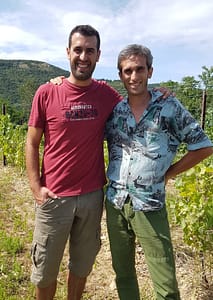Coming from Tenuta l’Armonia, crossing the A4 motorway I arrive in the small settlement of Villaga after three quarter of an hour. We are now in the Colli Berici area. Siemàn has nine hectares, but only four is planted with vines, since it’s important to maintain the biodiversity of animals and plants. We went to the top of the hill, where we got a magnificent view of the slopes with the naturally ventilated vineyards and we could see as far as the Apennines. The ground is limestone, some clay, and where the tai rosso (aka tokai rosso, aka grenache) is one of the most prominent grapes.
Siemàn means “six hands” in the local dialect. I am welcomed by four of them, Daniele and Marco Filippini, who share the duties in wine. Siemàn also makes beer, from grapes! – and it’s the third brother Andrea who takes care of that part.
Daniele (left) and Marco Filippini
The owl in the logo must be explained by Italian terms: Owl is gufo in Italian, and gufare means to be lucky. -We all have other professional backgrounds, explains Daniele and Marco. So the people said, you can’t succeed. So the owl has become a symbol for being a bearer of luck, and so far it seems that it was a lucky choice of logo.

The brothers have a low-intervention attitude, and there is meticulous cleaning at all stages. They don’t use pesticides or any chemicals in the vineyards. The grapes are almost exclusively autochthonous. In the cellar, fermentations takes place spontaneously with native yeasts, and nothing is added (except for a small quantity of sulphites, when necessary). The wines are kept in barrels, concrete and steel, according to what the consider best to express grape variety and land.
There is a high proportion of limestone in the vineyards, compared to the volcanic of the north side of the main road. There are two illnesses in the vineyards that need to be watched, oïdium and downy mildew. Oïdium is treated with sulphur. When it smells of mushroom you cut it off and throw it away. Mildew is normally treated with copper (mixed with water and sprayed onto the leaves). When the leaf looks as if it has oil on it, this part is burnt off. It is important to say though, that the amounts of both copper and sulphur are kept much lower than the legal maximum. This because they use fungus as a natural treatment to minimize addition of copper.
The first harvest was in 2013 (without label). –Angiolino Maule helped us in the beginning, say the brothers. (Read about his estate and wines here and in the article about Gambellara.) 2014, a very rainy year, was the first vintage on sale. The plantings are young also, only 4-6 years old. But all the wines have something to them. They are luscious, tasty and with a mineral character. And they will only get better in the coming vintages. -We are improving every year, says Daniele. And it’s easy to believe.
Camaleonte 2017 is a pét nat with second fermentation in bottle, from the grape varieties tai rosso, garganega and incrocio manzoni, the two latter (the white grapes) with two days skin-contact. The colour is deep yellow; on the nose some bread and citrus notes. an easy-drinking wine. In 2017 there were hailstorms that caused a 30% loss of grapes, says Daniele.
For the white and red wines, half is fermented in concrete, half in wood, then put together in stainless steel before bottling. Occhio al Bianco 2017, a still wine from that vintage -grapes garganega, tai bianco, and in some vintages incrocio manzoni- had shorter skin-contact and was subsequently lighter yellow, and also somewhat cloudy; white flowers and herbs on the nose; tasty with a salty mineral character in the finish. not very different was the 2016 version of the same wine: tai bianco and garganega, golden colour; white flowers like chamomile, and a slight touch of peel after 3 days of skin-contact. Mosca Bianca 2016, from 90% garganega and 10% moscato, stayed 2 days with skins. It’s yellow golden, aromatic with flowers (the small amount of moscato shines through), and a round body. The 2017 had only 1 day skin-contact, and another difference was the grape composition, 50/50 garganega/moscato. This one had some peel character, but only a little. For me it was still more aromatic, in the moscato way. This wine come from a rented vineyard in Colli Euganei (to the east, in the Padova province), and has volcanic soil. It has 5,5-6 g/L acidity, like all the wines. All wines also come with less than 15 mg total SO2 (the current selection between 2-14).
Occhio al Rosso is their only red wine, from tai rosso. The 2017 was the lightest of the lot (bright ruby), and maybe not as expressive; as the others; nice and juicy with some fresh cherry fruit though. 2016 was a hot summer. This wine was the darkest of the three; red fruits, cherry, blackberry; and fruit all the way. In the 2015 no sulphur was added, and a slight hint of brett. To me it doesn’t matter at these low levels. Furthermore, it was very fruitdriven, with red berries in the front. The colour was light cherry, and the appearance clear too.
Both beers are in a sour ale style. Le Bucce is spontaneously fermented with yeasts of grapes (tai rosso, red grapes). The other is the Incocio, from the white grape incrocio manzoni. The grapes are the main reason for the difference in colour.






